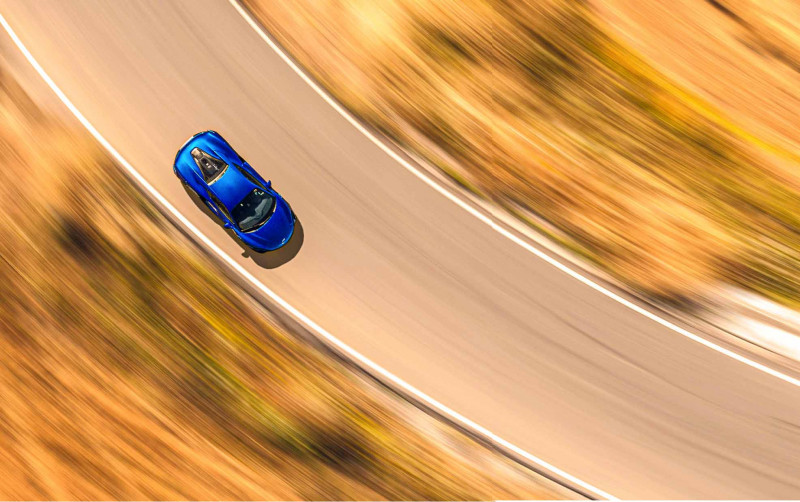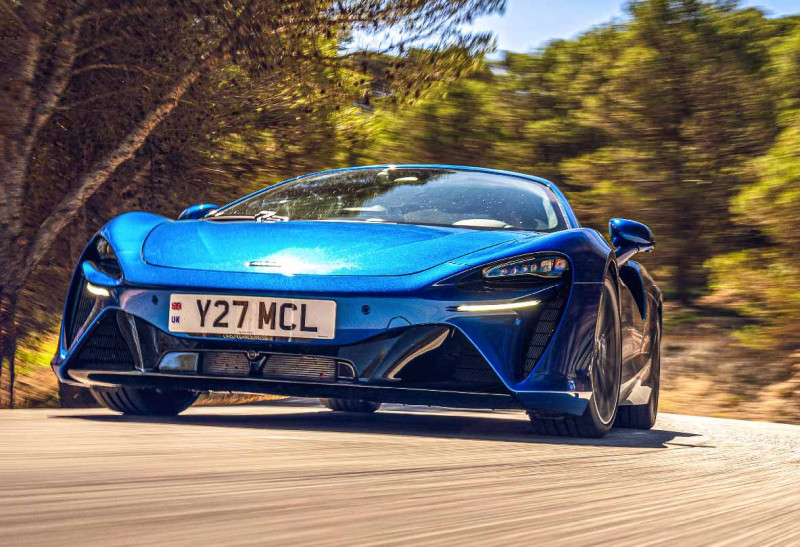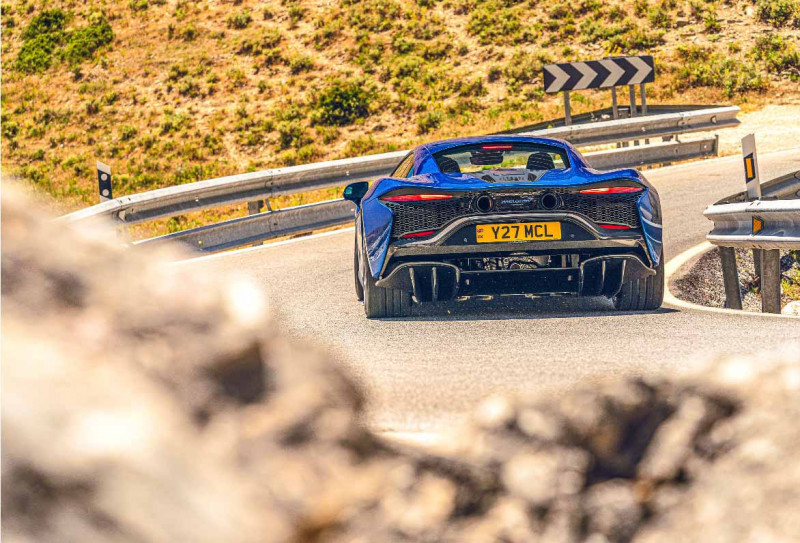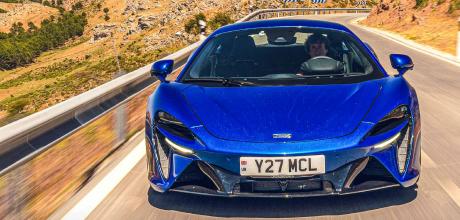300-mile Test 2023 McLaren Artura
McLaren’s next chapter opens with the clean-sheet Artura. New platform, new V6 plug-in hybrid powertrain, new… everything. How does it feel?
McLaren 2.0: batteries Included
McLAREN ARTURA
Words James Taylor
Photography Jordan Butters
The 300-mile Test

NEW CAR MEETS REAL WORLD
McLaren Artura: the 300-mile test The curious genius of McLaren’s new-era V6 hybrid
McLaren’s new Artura faces its toughest test yet 300-Mile test: McLaren’s new era begins with the Artura, driven on road and track
We’ve pushed our luck. McLaren needs the Artura back in an hour. We’re busy enjoying some spectacular canyon roads a good bit more than an hour north of the car’s scheduled return point in Marbella. Distance and time are going to require a little stretching here. So is fuel. My eyes are darting back and forth from the distance-to-destination on the Google Maps display (linked from my phone to the new infotainment screen) to the estimated range on the new instrument cluster. They’re within a mile of each other. This could be interesting.

All of which makes this a perfect final test to conclude our 300 miles with the Artura. This is, after all, a car that needs to be fabulously engaging to drive and to handle beautifully; it also needs to be comfortable over a long distance; to have a user interface that’s friendly and stressfree to operate; and it also – with its box-fresh plug-in hybrid powertrain – needs to be energy-efficient. And up for a challenge.
The Artura (a name, not a code like previous core McLaren models; it combines ‘art’ and ‘future’) represents the next chapter for McLaren Automotive as it gets into its second decade of car making. It’s the most comprehensively new model since modern-era McLaren road car production began with the 12C in 2011.

It’s a new platform with a new carbon monocoque design (built in McLaren’s new Sheffield facility); new ‘futureproof’ electrical architecture; new plug-in hybrid powertrain, including a new V6 engine and eight-speed transmission, integrated with the electric motor – and, for the first time in a McLaren, an electronically controlled limited-slip differential, or e-diff; new multi-link rear suspension; new interior architecture, and much more besides. Those elements will be the basis for McLaren’s next generation of models, all of which will have hybrid powertrains.

Duck under the butterfly door and climb in (a cleverly designed sill shape in the new chassis helps here) and you’re struck by McLaren’s new interior architecture: smart, sober and slick, with its new touchscreen tucked down below the dash’s centreline on what looks like a movable armature (but isn’t).
That low-set position means you need to do a fair bit of focusing and refocusing between the road ahead and the display below the dash’s centre line. The interface takes a bit of learning but works well enough and will become yet slicker over time with over-the-air updates. The car’s electrical architecture as a whole (ethernet-based, requiring 25 per cent less physical wiring than before) can be updated remotely too, for all aspects of the car’s software and functionality. But the steering wheel ahead of you is gloriously clean and uncluttered: no buttons or switches (which makes changing radio stations and the like more of a faff but worth it for the clean feel and appearance). This is still a car that’s all about driving, first and foremost.
So let’s drive. The Artura defaults to pulling away under electric power. Depress the throttle fully in Electric mode and it won’t fire the engine up. Nor will it accelerate dramatically away from a junction – it’s programmed to be a gentle, smooth build-up to preserve energy from the relatively small 7.4kWh battery, positioned under the fuel tank (where it steals a bit of fuel space; but then adds e-range, so no real net loss). The motor is about the size of a dinner plate, and housed within the casing of the new eight-speed dual-clutch gearbox, driving the rear wheels only. It’s a neat bit of packaging. The Artura can travel at up to 80mph under e-power alone. These canyons, worthy of a John Wayne Western, are dotted with sleepy little towns. They remain sleepy as the Artura swooshes through in near-silent Electric mode. There’s whine from the motor/transmission (the e-motor runs through the gearbox but you can only change gears manually when the petrol engine’s running), but it’s far from intrusive.
The engine chimes in automatically as the battery runs down, or if you shift drive modes. The 3.0-litre V6, designed by McLaren and built by Ricardo, is 50kg lighter and 190mm shorter than the V8 that powered previous McLarens, enabling a shorter wheelbase (30mm less than that of the 570S and 720S). In overall length the Artura is similar to a 720S but it’s narrower, useful for threading through winding country roads and urban streets alike. The V6’s ultra-wide 120º angle lowers the centre of gravity and allows plenty of space centrally between the cylinder banks to site its twin turbos. Its low-set angle also gives fantastic rear visibility over the deck of the engine bay. This is a truly easy supercar to see out of and manoeuvre, helped by 360º parking cameras. Handy when you take the wrong junction and need to do a five-point turn between a rock face and a sheer drop. I tried it so you don’t have to.
The V6 is full of torque and power, but like its V8 forebear it’s not a particularly melodious powerplant, sounding purposeful but a little gruff and industrial. Sound’s a subjective thing, though. Objective performance is plain: the Artura is thumpingly quick.
Assuming, that is, you’re in the right mode. You toggle through the drive modes on rocker switches on top of the digital instrument cluster, which moves together with the wheel, as on the McLaren Elva. Comfort mode blends engine and motor, using electric drive when the V6 is under low load and short-shifting through the gears when the engine’s in play. Sport prioritises the engine, downshifts earlier and upshifts later. Track is sledgehammer mode, with the motor there predominantly to boost acceleration and provide ‘torque-fill’ compensation for turbo lag at lower revs. The battery is topped up by the engine when you’re not at full throttle, ensuring the motor’s always primed to contribute to a 671bhp/513lb ft total.
Comfort mode is great for typical driving, but we’re in a hurry so Track mode it is. And Andalucia obliges with deserted roads, carved into the hillsides like a tarmac toboggan run. Mostly the long, cambered meanders are smooth but the occasional mid-corner bump lies in ambush.
You hear them thud through the McLaren’s chassis but don’t feel them through the steering – it’s remarkably composed, refusing to be thrown off its line. There’s the occasional wildlife ambush too, with birds picking at roadkill on the sun-baked tarmac. The Artura has enough front-end grip and chassis poise to change line mid-corner and side-step neatly past, even at committed speeds. If you’re really pressing on, balance is primarily towards understeer, just like the 570S. That’s not a criticism; it gives you a stable base to lean on and work from, and it’s far from inert or uninvolving to drive. Unlike some highend supercars, you don’t feel like a passenger hanging on for the ride while the car grips, grips and grips some more. You’re definitely driving. You feel the Artura working its tyres, feel its weight transfer.
And you feel it all through power steering which feels marvellous. It’s a new system but, like previous McLarens, it’s electro-hydraulic rather than electric power assistance. It’s not a big talker; it doesn’t writhe around in your hands over bumps and cambers and feels almost spookily calm – ironically, almost like an electrically-assisted system. But it’s fantastically linear and smooth. The Artura is a one-corner, one-turn kind of car.
Braking, too, is consistent. Energy regeneration is not linked to the hydraulic brake system, so the pedal always feels the same every time you stand on it (particularly once the standard-fit ceramics are warmed up). Like previous McLarens, they have a pleasingly short travel and need a good firm press, almost like a racing car.
Talking of which, before setting out on our road trip we drove an Artura on track too, at the rollercoaster Ascari race resort. Imagine a set of the trickiest corners you can think of, then make most of them blind by draping them across a rolling set of Andalucian hills. It’s fantastic. The only difference between the silver car we drove on track and the blue one in which we’ll eventually cover more than 300 miles on the road is an optional set of six-point harnesses and standard Clubsport seats (fixed shells with adjustable cushioned panels; they’re brilliant), and stickier Pirelli P Zero Corsa tyres.
McLaren research suggests a large proportion of its customers use their cars on track, and part of the Artura’s brief was to have repeatable performance – there needs to be as much energy on tap from the battery after 10 hard laps as there is at the start of a run. Stability under braking is impressive, with very little weave or wander even in a last-gasp anchor-drop into a hairpin from high speed. That’s aided by the new multi-link rear suspension design, adopted not only for packaging advantages but also for increased toe stiffness.
Most impressively, though, even after all these changes, all these new components, the Artura still feels like a McLaren. It has the same handling characteristics we’ve enjoyed in its predecessors. Weight increase over the 570S is remarkably scant. Despite the hybrid system and the increased refinement, particulate and equipment demands of a modern car, it weighs less than 50kg more like-for-like than a 570S coupe. That relative lack of mass really helps on both track and road.
In fact, the Artura feels very reminiscent of the 570S in general, although it’s not a direct replacement for the old Sports Series models (540C, 570S, 600LT et al), as it’s shifted upmarket to a higher price and performance position. So, on this charge back to base, I trust the Artura implicitly, carrying far greater speed, turning in earlier and braking later than I’d dare in other cars. It’s a drive to savour, even if there isn’t time to. As we approach Marbella the tank is nearly empty but there’s charge in the battery (you can toggle between minimum and maximum charge modes on the fly, to ensure you’ve a bit of energy ready for use in town, for example) so the Artura and I whisper (or faintly whine) through traffic-clogged streets to our final drop-off point.
It’s a chance to reflect on what’s proven to be a nuanced car. In some ways the Artura feels a little aloof in character; it’s less raw and immediate an experience than previous McLarens. But it has greater bandwidth. The ability to trundle through towns or do a three-point turn in a crowded square amid a sea of camera phones without the engine running (reverse is taken care of by the motor; there’s no reverse gear in the ’box) is an oddly calming feeling. As would be a cold-start early-morning airport run without waking all your neighbours up. But when you’re going for it, on a track or on the road in Track mode, the Artura doesn’t feel like a hybrid; more like a conventional supercar with an added e-boost function. It’s cleverly packaged, and McLaren’s weight-saving work is magical. It’s by no means perfect. Despite the engine’s muscle, it’s not a spine-tinglingly evocative powerplant. And to some eyes the Artura’s design is overly cautious. It’s a new car that doesn’t directly replace the 570S, and occupies a different market position – but looks like a facelifted 570S. That’s not to say it doesn’t turn heads, however.
Throughout our journey we’ve met onlookers who go out of their way to tell us it’s a beautiful car, and its compact proportions make it all the more appealing. I like it. Ours was fine, but some other cars on the Artura’s media launch – an event delayed from its originally scheduled date last year – experienced reliability issues with heat and software. The cause of the former has been identified and rectified, and the latter should be fixed by a software update which was already scheduled to take place before production of customer cars begins. None of those issues are expected to be a factor for customer-spec Arturas. Battery nearly depleted, tank nearly empty, we’re here. Phew. Almost on time. Made it. The Artura deserves to make it too, in the challenging world it finds itself launching into. This is a car of real depth, and deep appeal.
It’s a nuanced car. The hybrid powertrain gives it greater bandwidth than a conventional supercar
TECHNICAL DATA2023 McLaren Artura
- PRICE £189,200 (£217,670 as tested)
- POWERTRAIN 7.4kWh battery, 2993cc twin-turbo V6, e-motor, PHEV, eight-speed dual-clutch auto, rear-wheel drive
- MAX POWER 671bhp @ 7500rpm,
- MAX TORQUE 531lb ft @ 2250rpm,
- ACCELERATION 3.0sec 0-62mph,
- PERFORMANCE MAX SPEED 205mph (limited)
- ON SALE Now
- WEIGHT 1498kg
- EFFICIENCY 61.5mpg (official), 16.3mpg (tested),
- Data 104g/km CO2
- RATING ★★★★★
▲ PLUS Handling; performance; usability; versatility
MINUS ▼ Cautious design; dull-sounding engine; teething troubles
ALTERNATIVES
Maserati MC20 Not a hybrid but is an elegantly designed, carbontubbed V6 supercar – and a good one
Lamborghini Huracan Tecnica Resolutely unhybridised and rear-drive. Old and cramped but big on charisma
GEORG KACHER’S VIEW
Our European editor has been putting hard miles on an Artura too. Here’s his take: What the Artura has… The best steering in the business and a professionally sorted chassis: planted, sufficiently playful and sublimely balanced. At last, enough cabin space for tall occupants too. What it lacks… Mod cons like laser lights and an overboost button; faster charging to feed the neo-smartphone battery; and a design that shouts, ‘No, I’m not a facelift – I’m a brand new car!’ And the Ferrari comparison? Ferrari’s 296 GTB isn’t necessarily a direct rival as it’s a marked step up in price and power. But as a new V6 hybrid, it’s an inevitable comparison to draw. The Ferrari feels even more agile, always eager to attack. But the Artura is more composed overall, rides better and trades two-tenths sports car DNA for the same in GT genes. Nice one, guys.
The steering is fantastically linear and smooth. The Artura is a one-corner, one-turn kind of car. Artura is hugely grippy but 671bhp can help unstick it Wheelbase is actually shorter than a 570S’s Spain: good at driving roads. Track is where the RS comes alive and makes sense.
That rear deck is one gigantic aluminium panel, for a cleaner shape and low weight. Flying buttress design ducts airflow and gives it a clear run onto the rear deck. Looks like older McLarens but Artura is from a clean sheet
RE-ACTIVE DRIVE MODES
Previous McLarens had an ‘active panel’ for drive modes, with wingnut shaped toggle switches on the centre console. In Artura, the system’s transposed to rocker switches on top of the instrument panel.
SMART SCREEN
New infotainment system incorporates Apple CarPlay and Android Auto in portrait configuration. Dial on side controls volume, or click it to shortcut to home screen.
DOWN THE LINE
New heating and ventilation system blends conventional vents with this fissure down the centre of the dash, like in a Tesla Model 3. It’s quicker and quieter to cool the cabin.
Pick-up: 0 miles
Is it on? Press the starter and there’s no engine sound: Electric mode is the default start setting. I press the button again and switch the car off. Oops.
1.2 miles
The V6 awakens for the first time automatically but we can still travel by e-motor alone should we wish. WLTP electric range is rated at 19 miles.
13 miles
We’re beyond the city limits and past an A-road stretch, where the Artura rides well and is refined at a cruise by supercar standards. Now for rural roads.
14 miles
Battery’s depleted. We’ve been driving in Comfort mode for much of the time, which dips into electric power frequently. Engine can help recharge.
26 miles
Artura feels right at home here. It’s carrying negligible extra weight over a 570S and its steering is smoothly accurate, perfect for a road like this.
111 miles
Vertiginous speed bumps abound in these villages. Nose lift (a no-cost option) is essential to avoid skimming the nose. With it, the Artura copes fine.
124 miles
It’s still rear-wheel drive, so no drive gubbins to impinge on front boot space, which is deep and roomy. Our sandwiches have got a bit warm, mind.
125 miles
Time to fill up. Official WLTP economy is 61.5mpg – cloud cuckoo land like all PHEVs. We’re on 16.3mpg but we are enjoying ourselves.
189 miles Design might be conservative but it’s neat, elegant and compact and turns heads, especially with the optional £7500 Volcano Blue metallic paint.
221 miles
Artura is the first McLaren with an electronic limited- slip diff, or ‘e-diff.’ Previous models had an open diff with ‘brake-steer’. The new diff feels good.
297 miles
Poor butterflies. There are a lot of grilles, doing a lot of cooling. They appear exposed but in-built guards should protect them from stones.
Drop-off: 324 miles
Back on time (just). Lots to think about here; this is a car that needs time and miles to fully get under your skin. Meanwhile, let’s plug it in to charge.


